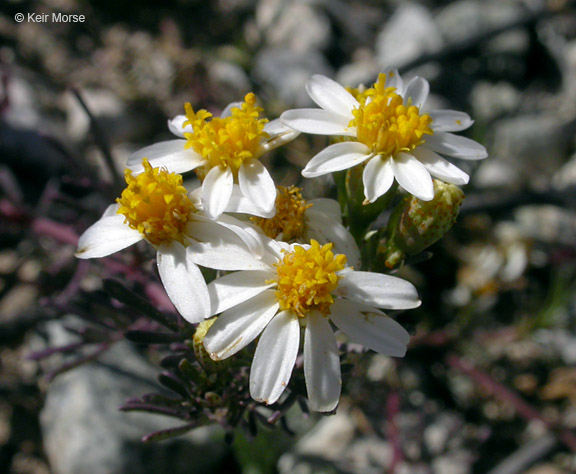Annuals, green, 3-12+ cm, glabrous. Stems spreading to ascending or erect. Leaves alternate; blades 10-15 mm overall, lobed, lobes (3-)5-9, linear to filiform. Peduncles 1-5+ mm, glabrous. Calyculi 0, or of 1-2 subulate bractlets, lengths less than 1/2 phyllaries. Involucres obconic to campanulate, 5-6.5 mm. Phyllaries 8-16, margins of outer distinct less than 1/2 their lengths, abaxial faces glabrous. Ray florets 9-12; corollas white to pale yellow, laminae 3-4 × 1-3.5 mm. Disc florets ca. 25; corollas pale yellow, 3-4.5 mm. Cypselae 2.5-3 mm; pappi of 10-15 scales (each comprising 5-9 basally connate bristles) 1-2.5 mm. 2n = 16.
Flowering spring, following rains. Sandy washes and flats, in deserts; 50-100 m; Ariz.; Mexico (Sonora).
Duration: Annual
Nativity: Native
Lifeform: Forb/Herb
General: Herbaceous annuals, to 12 cm tall or more, stems erect, branching from base, herbage green, glabrous.
Leaves: Alternate, blades 10-15 mm overall, pinnately-lobed with 3-9 linear to filiform lobes, blades somewhat thickish and succulent-looking.
Flowers: White to pale yellow with yellow centers, in radiate heads; ray flowers 9-12 with white to pale yellow laminae 3-4 mm long and 1-3.5 mm wide, disk flowers yellow, about 25 in number, corollas 3-4.5 mm long, involucres obconic to campanulate, 5-6.5 mm long, without subtending calyculi and nearly naked at the bases, phyllaries 8-16, united to three-fourths of thier lengths or more, with surfaces covered with small, conspicuous, rounded glands, infloresences generally solitary on glabrous peduncles 1-5 mm long.
Fruits: Cypselae (achenes) 2.5-3 mm long. Pappi of 10-15 scales, each dissected into 5-9 basally connate bristles 1-2.5 mm long.
Ecology: Found in sandy washes and on flats in desert communities, from 150-350 ft (45-106 m); flowering in spring, following rains.
Distribution: Arizona; Mexico.
Notes: The plump, thinly-lobed leaves of this small annual appear to stand erect along the stems, giving this plant a somewhat bristly or bottle-brushish look; the singular heads at the branch tips have fairly large white ray flowers surrounding a center of bright yellow disk flowers and the involucres have somewhat conspicuous phyllaries; other good identifiers for this species are the annual life-span, the involucre essentially naked at the base, and the phyllaries untied to three-fourths of their length or more, their surfaces with conspicuous small, roundish glands. Look for this species under Dyssodia concinna in older texts.
Ethnobotany: Specific uses for this species are unknown, but other species in the genus have uses.
Synonyms: Dyssodia concinna, Boeberastrum concinnum, Hymenatherum concinnum
Editor: LCrumbacher2012
Etymology: Thymophylla comes from the Greek thymos, "thyme," and phyllon, "leaf," meaning "thyme-leaved", while concinna means neat, well-made, elegant.






